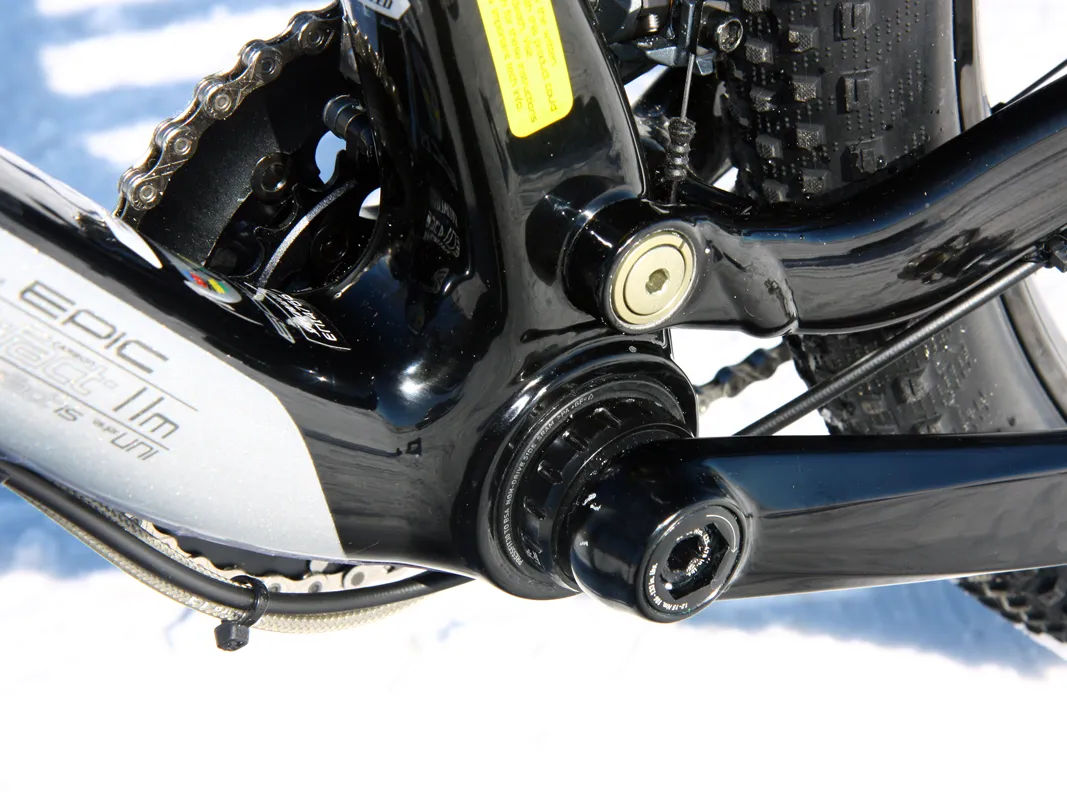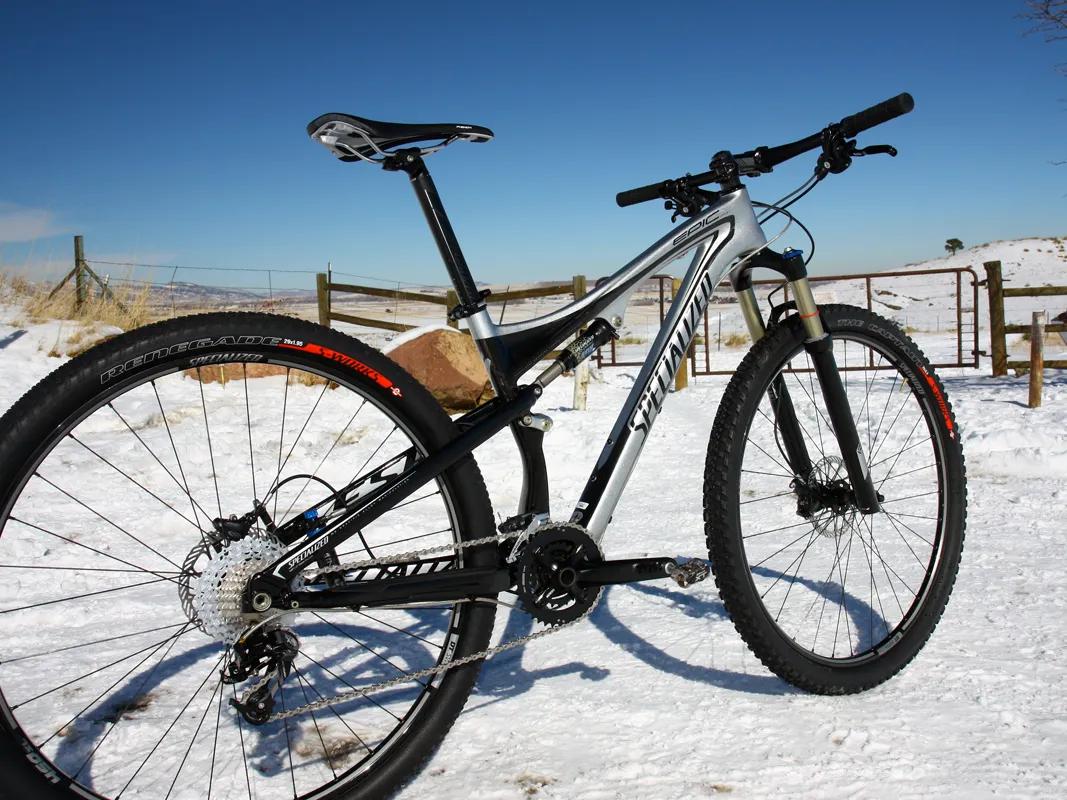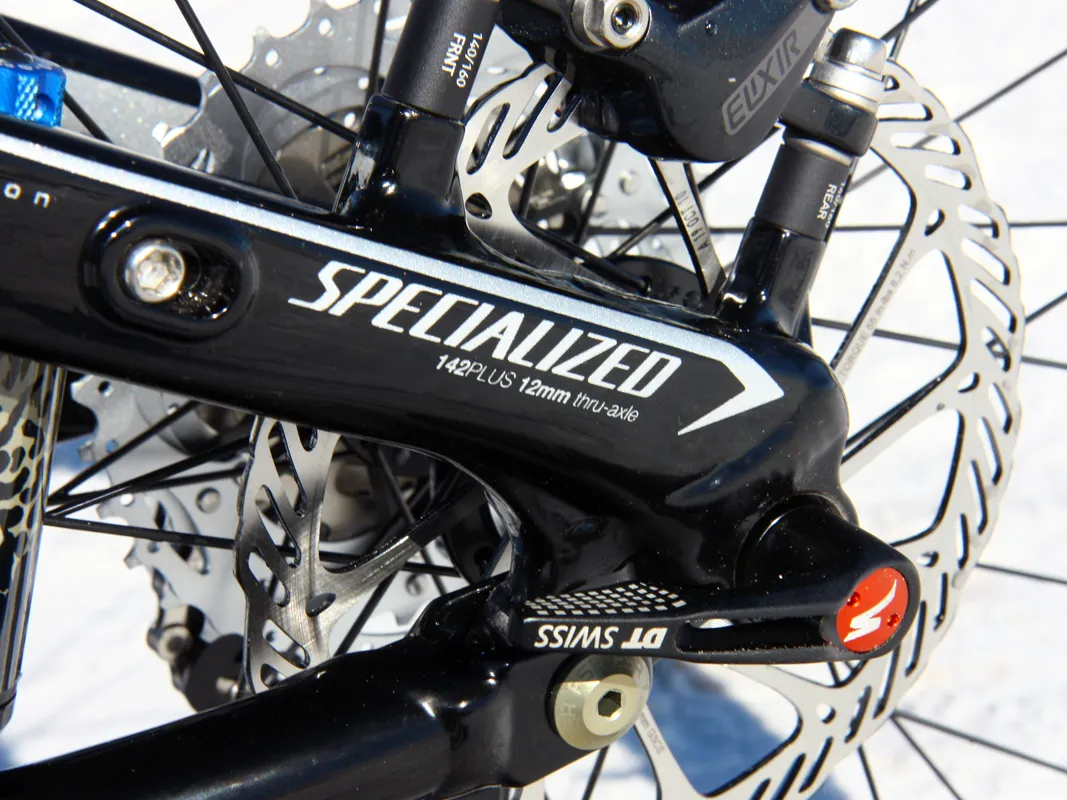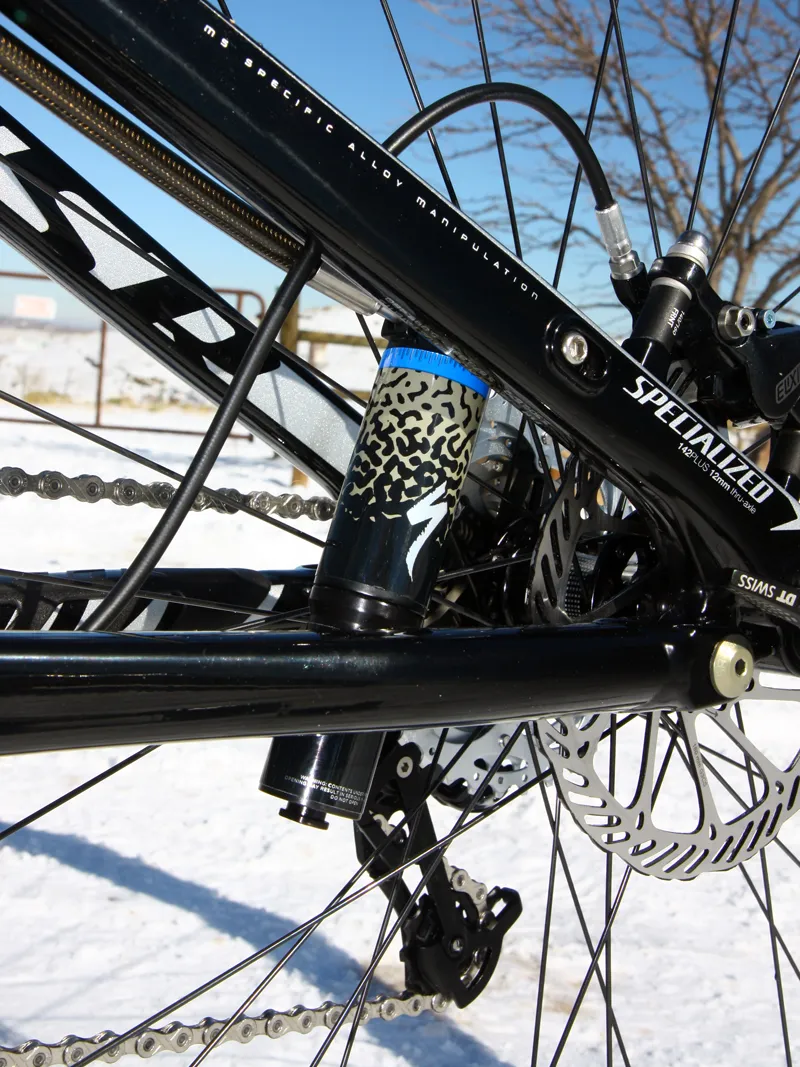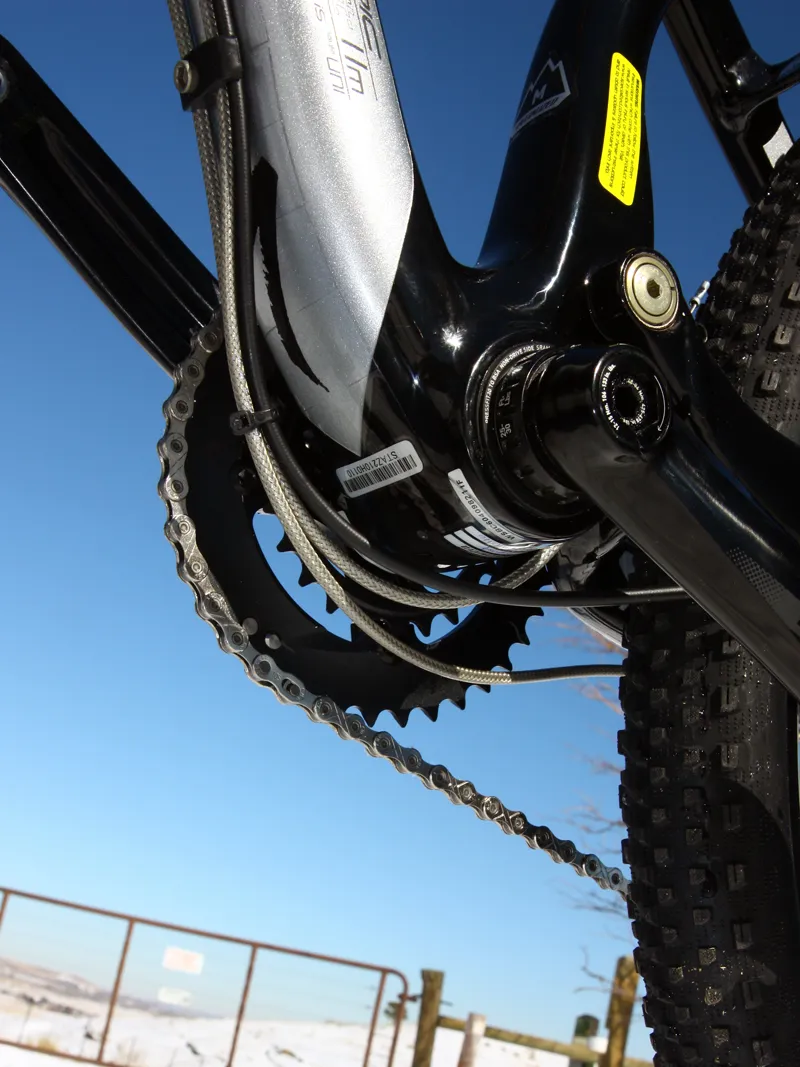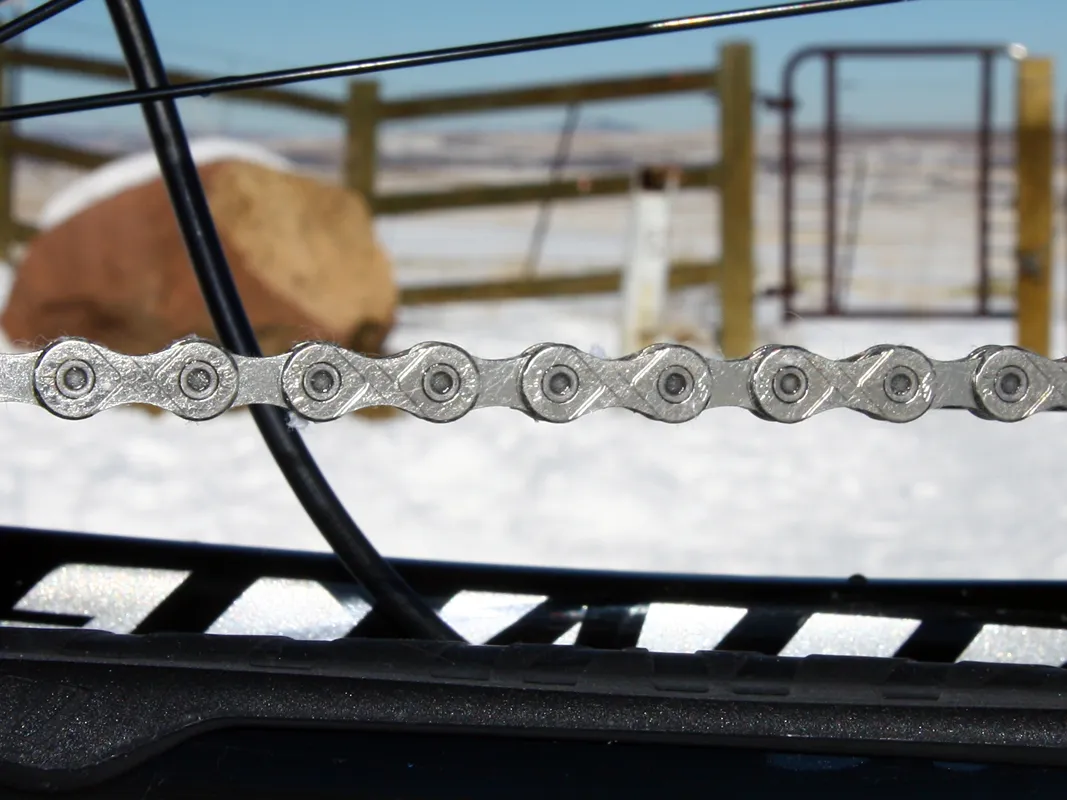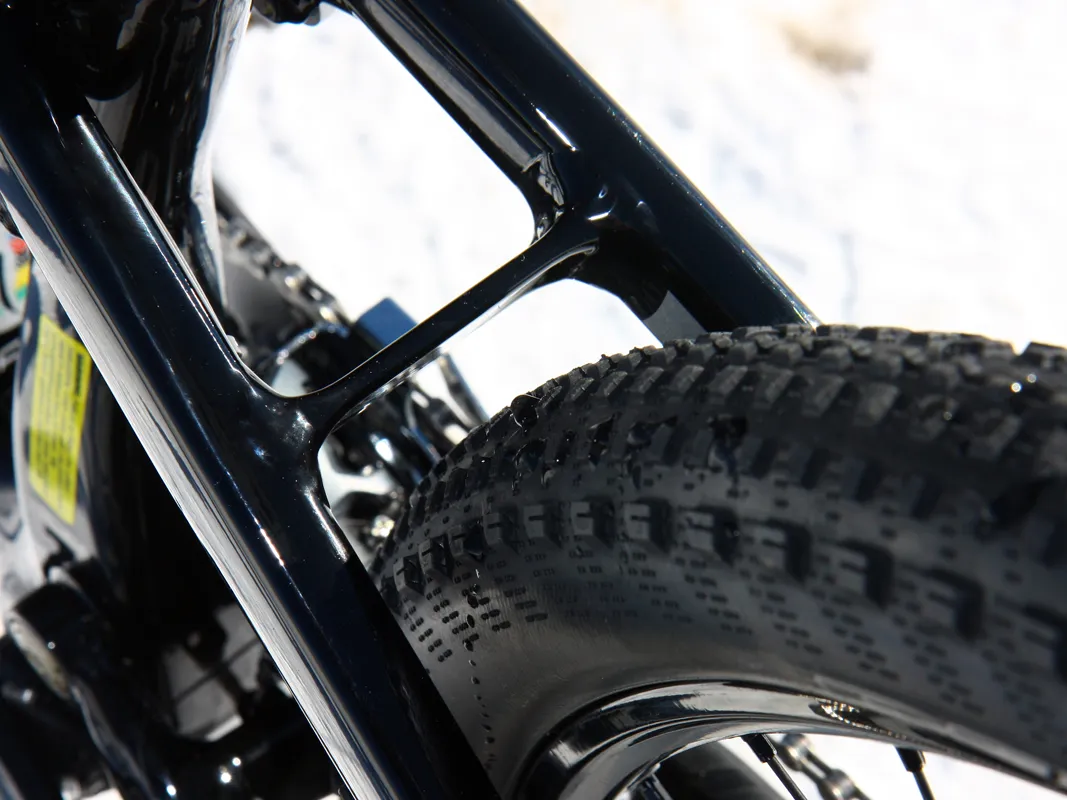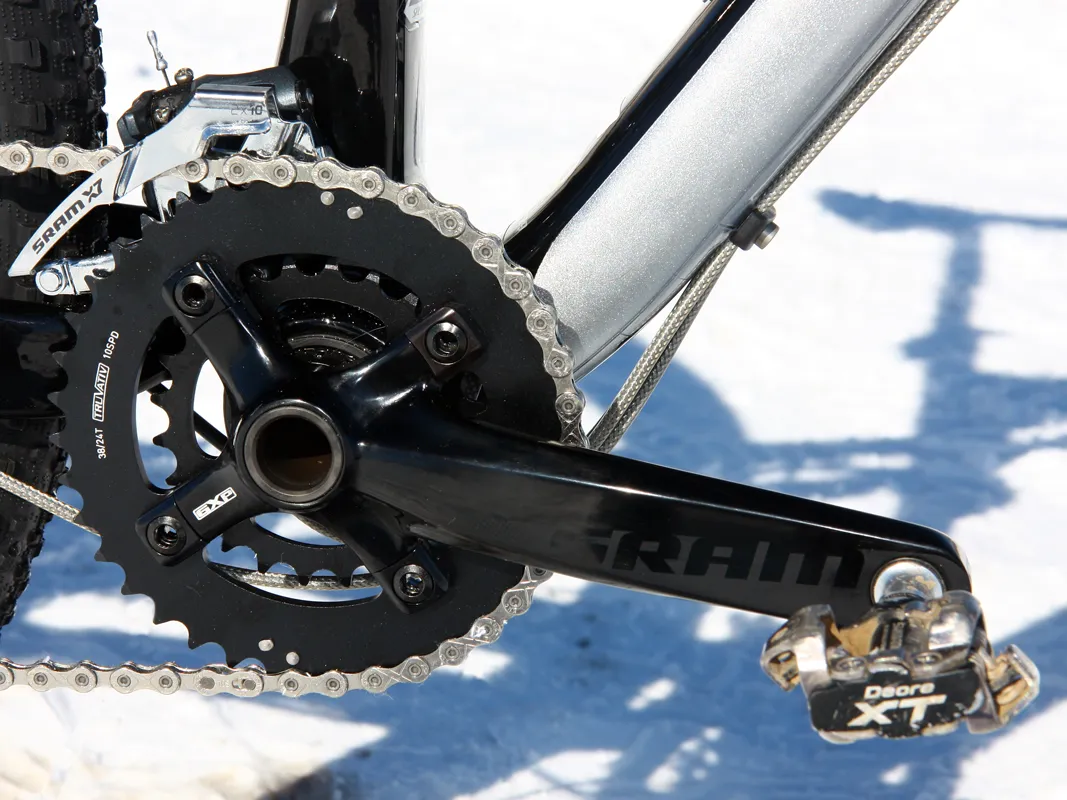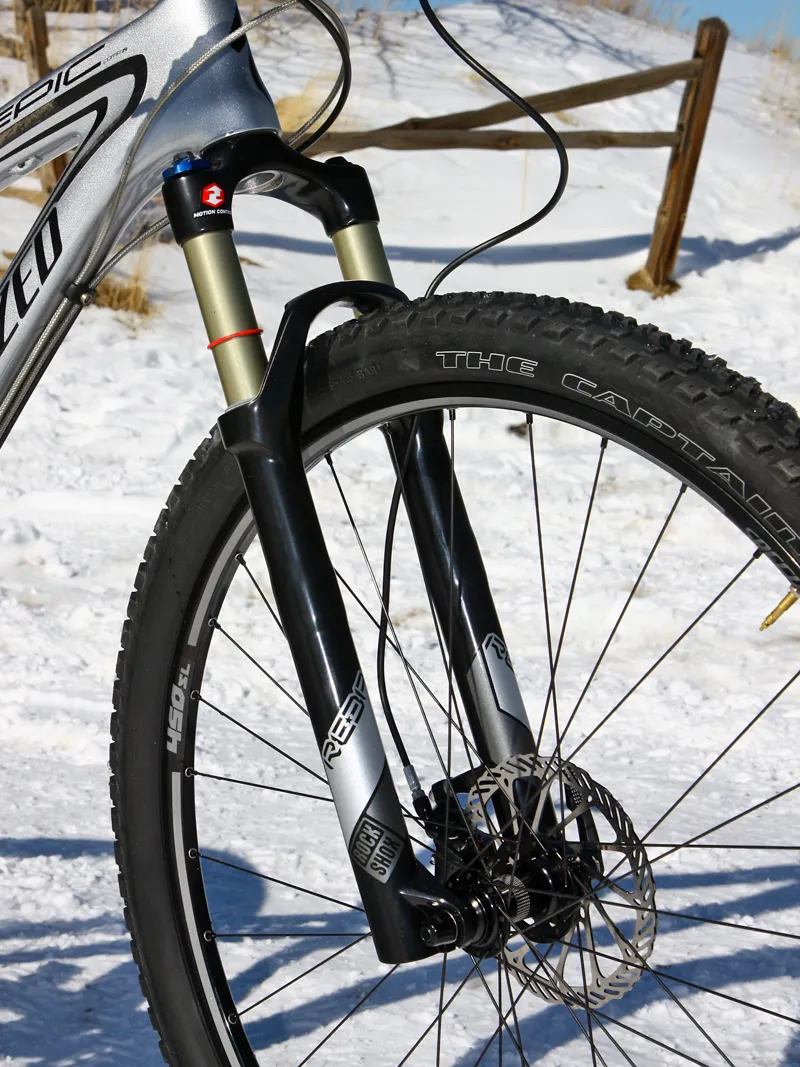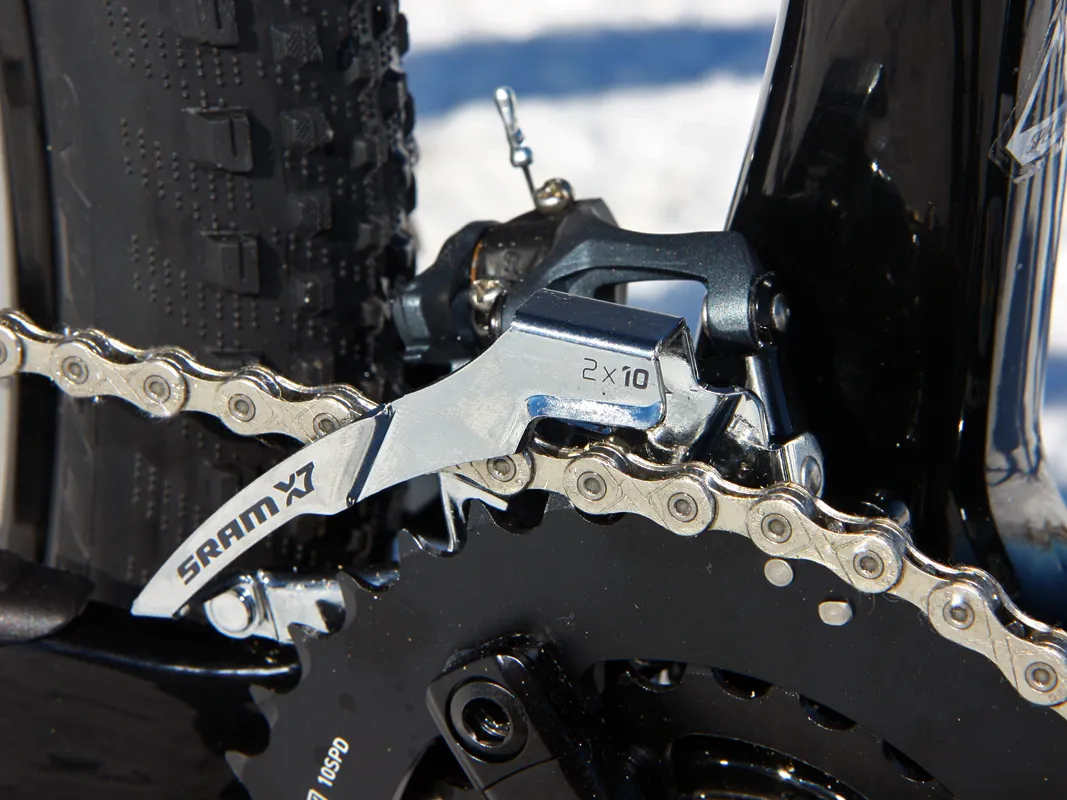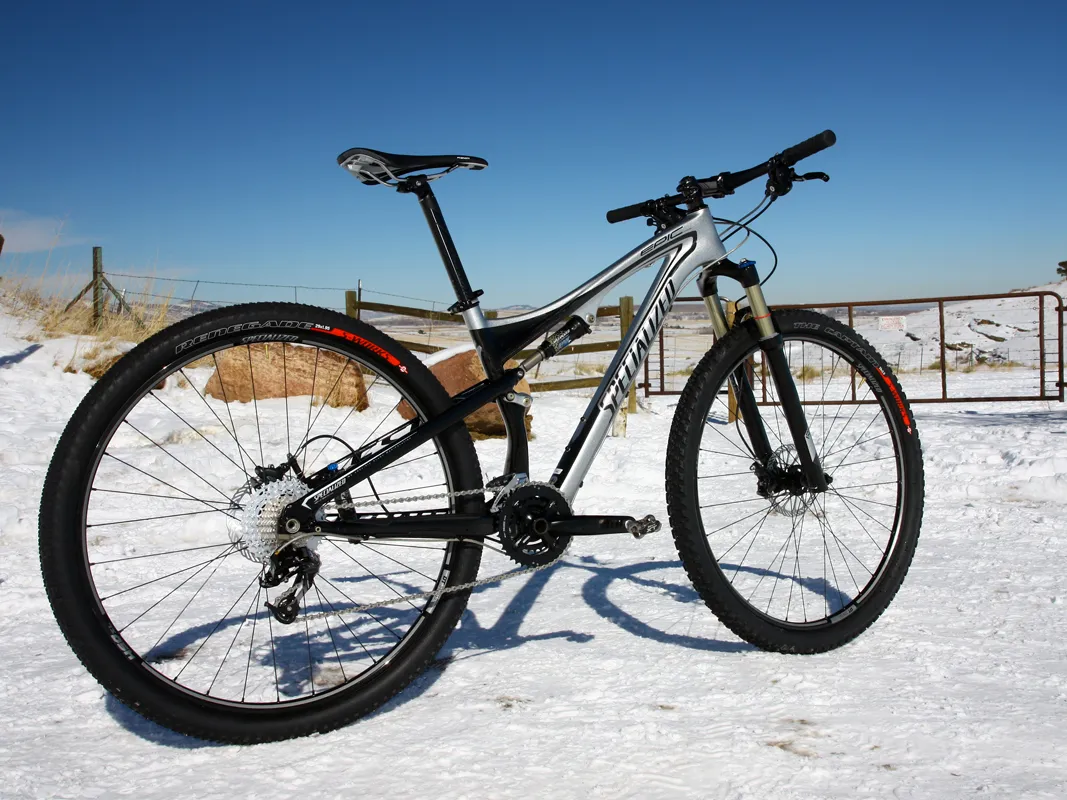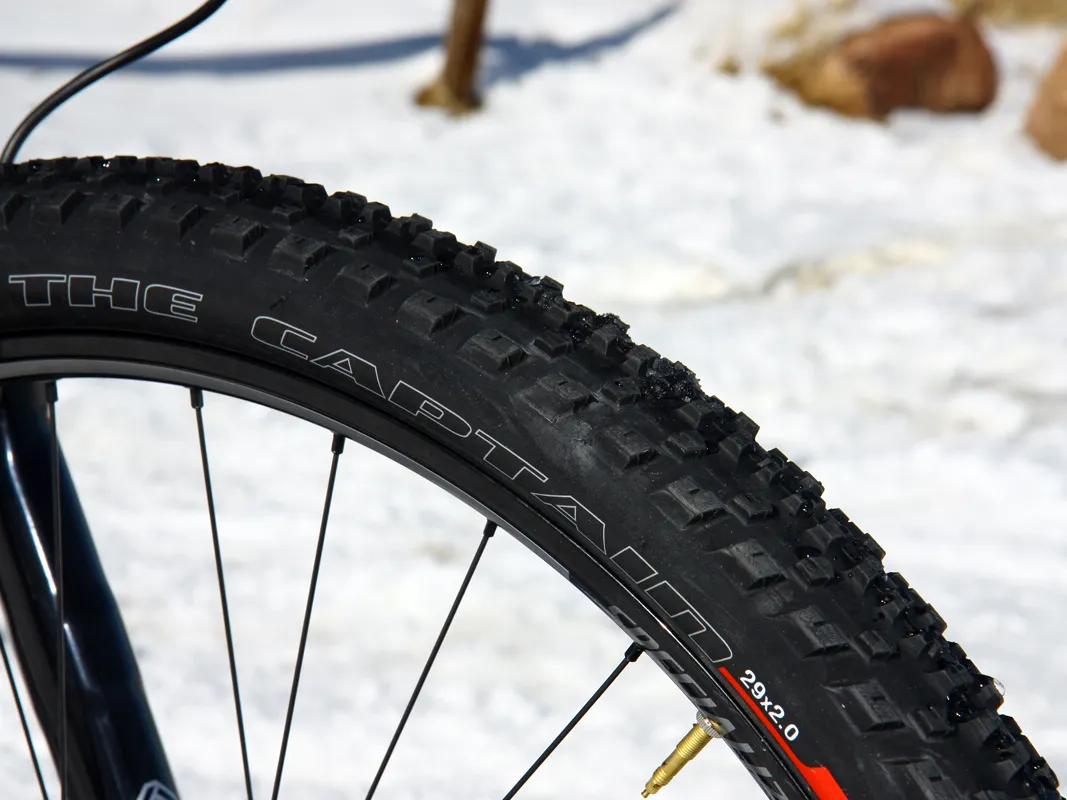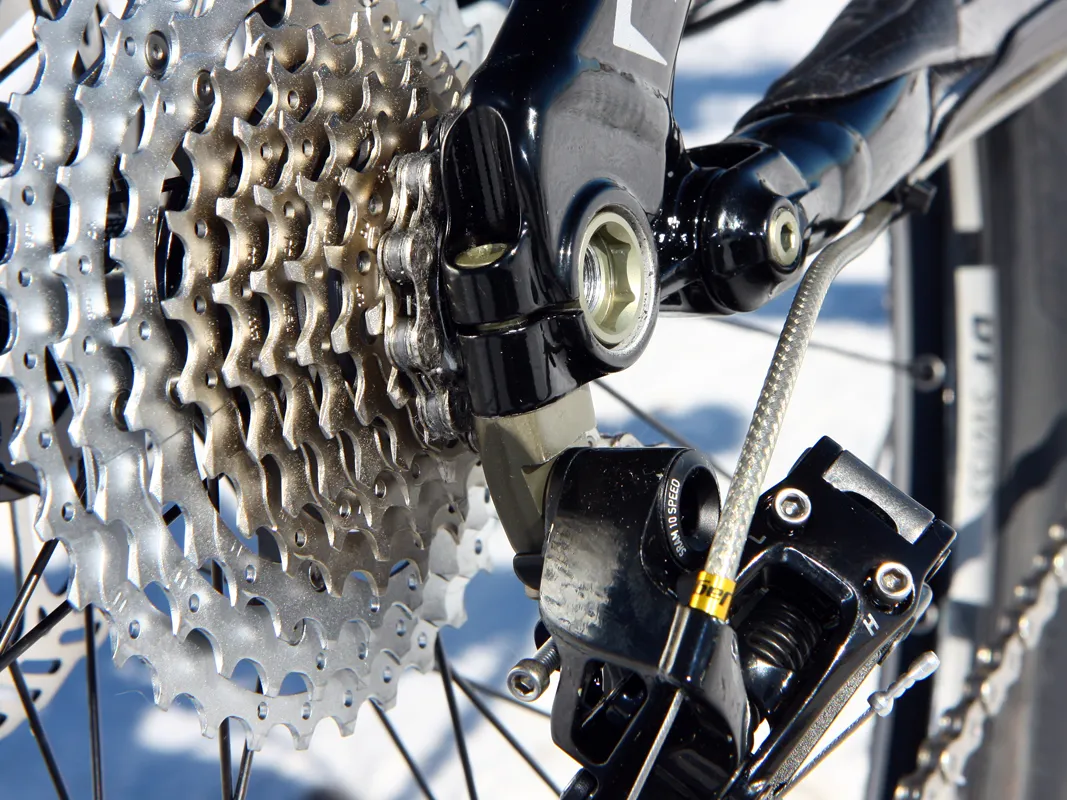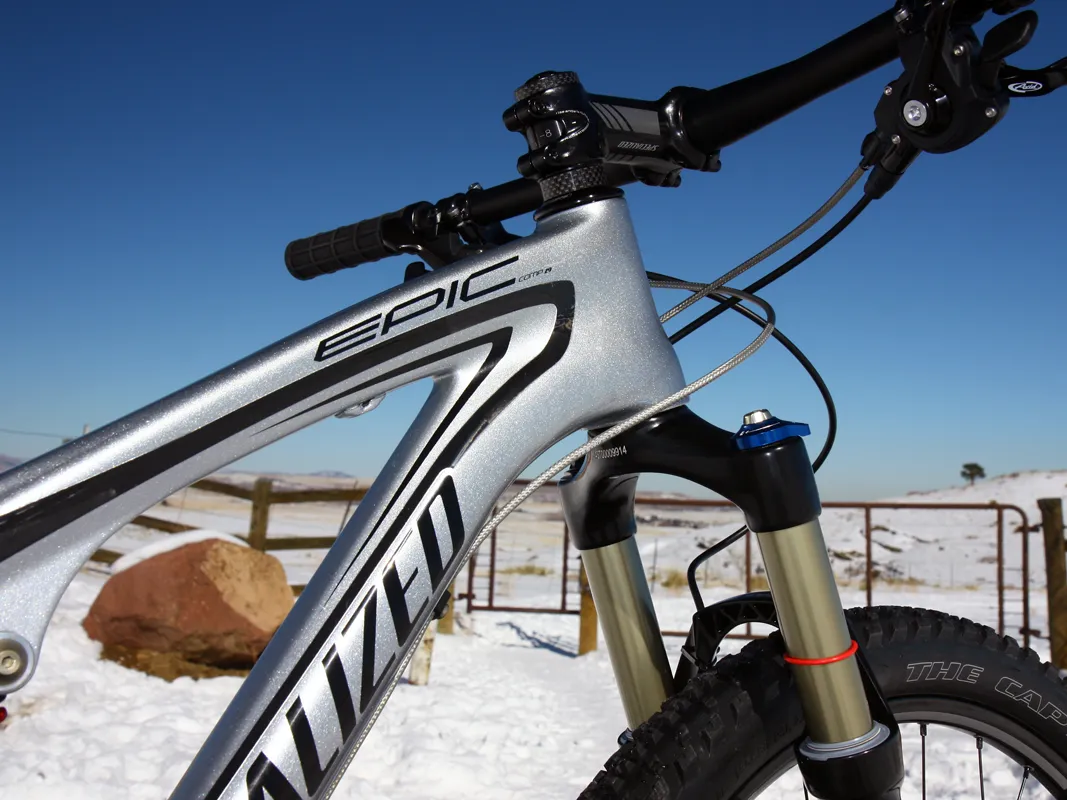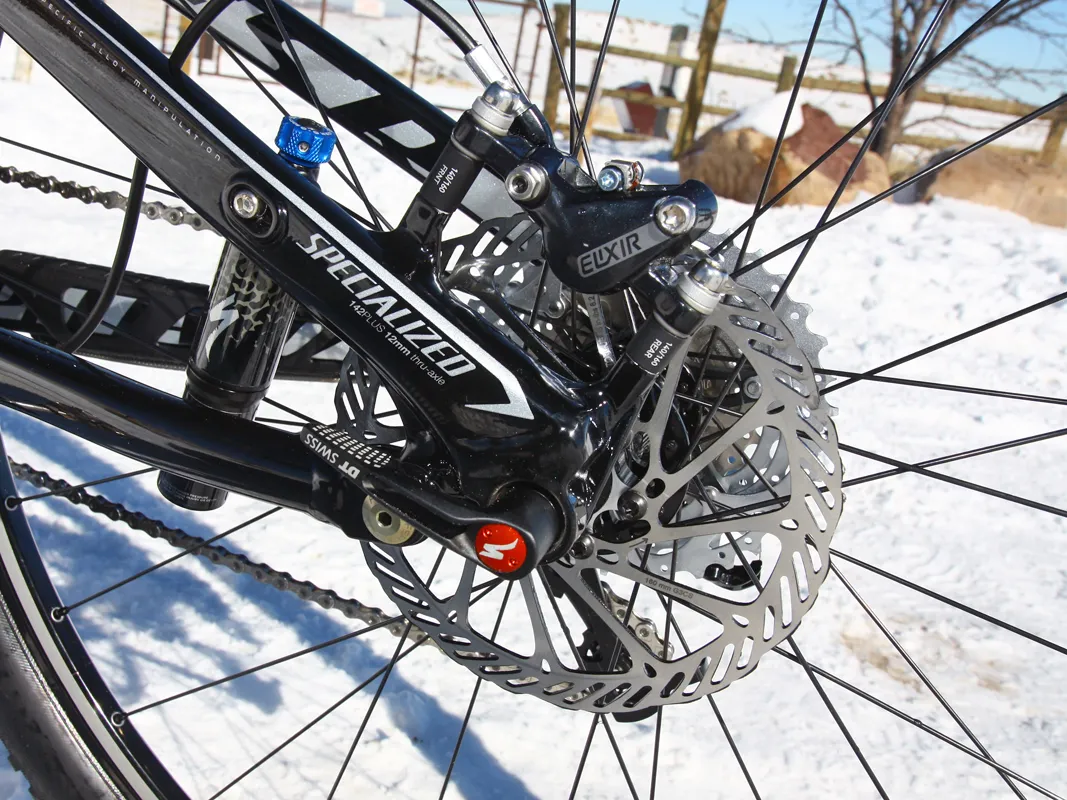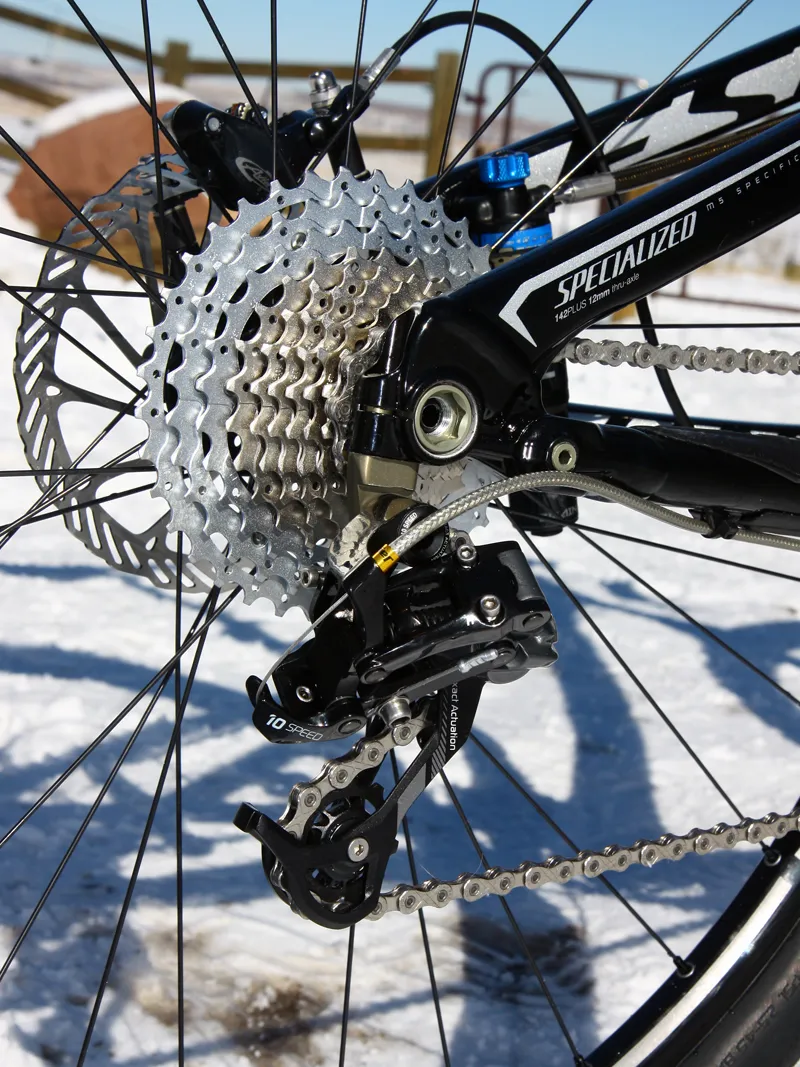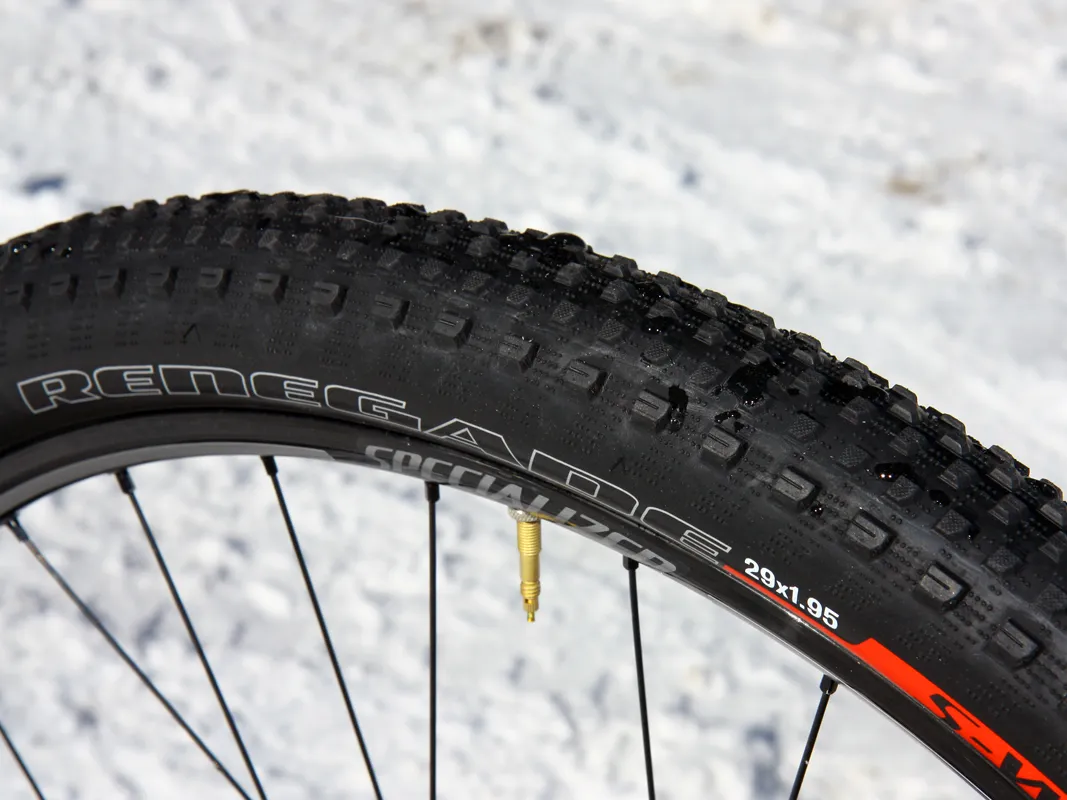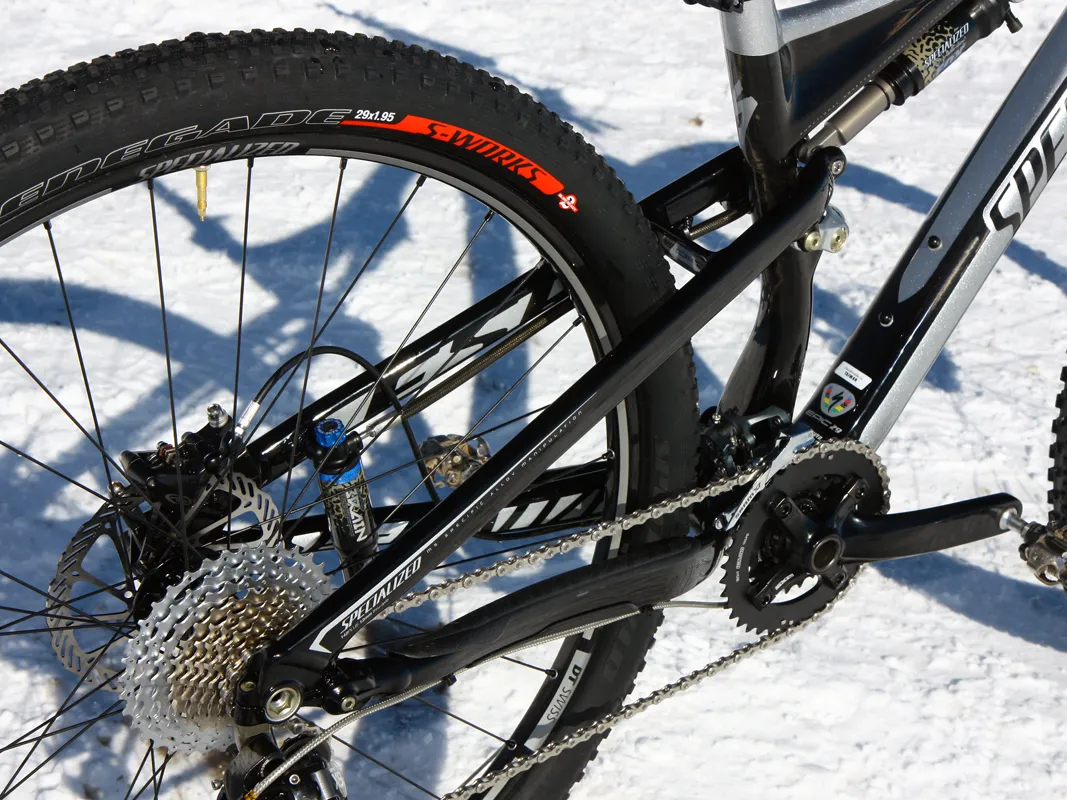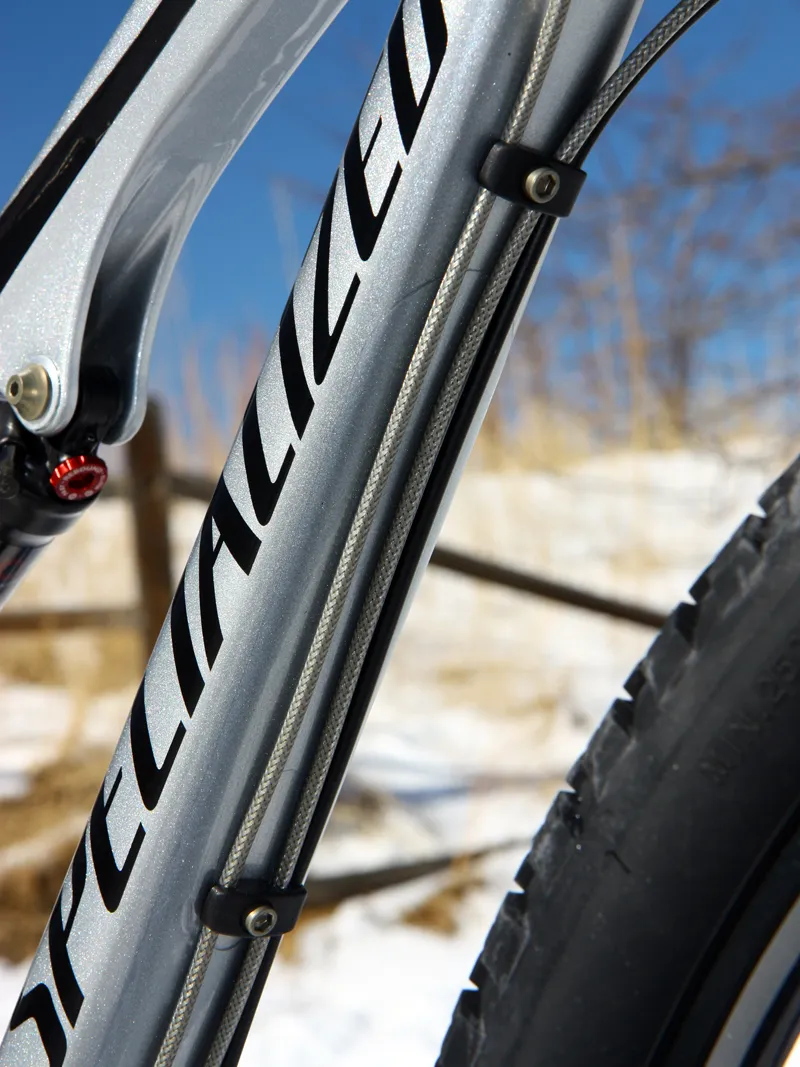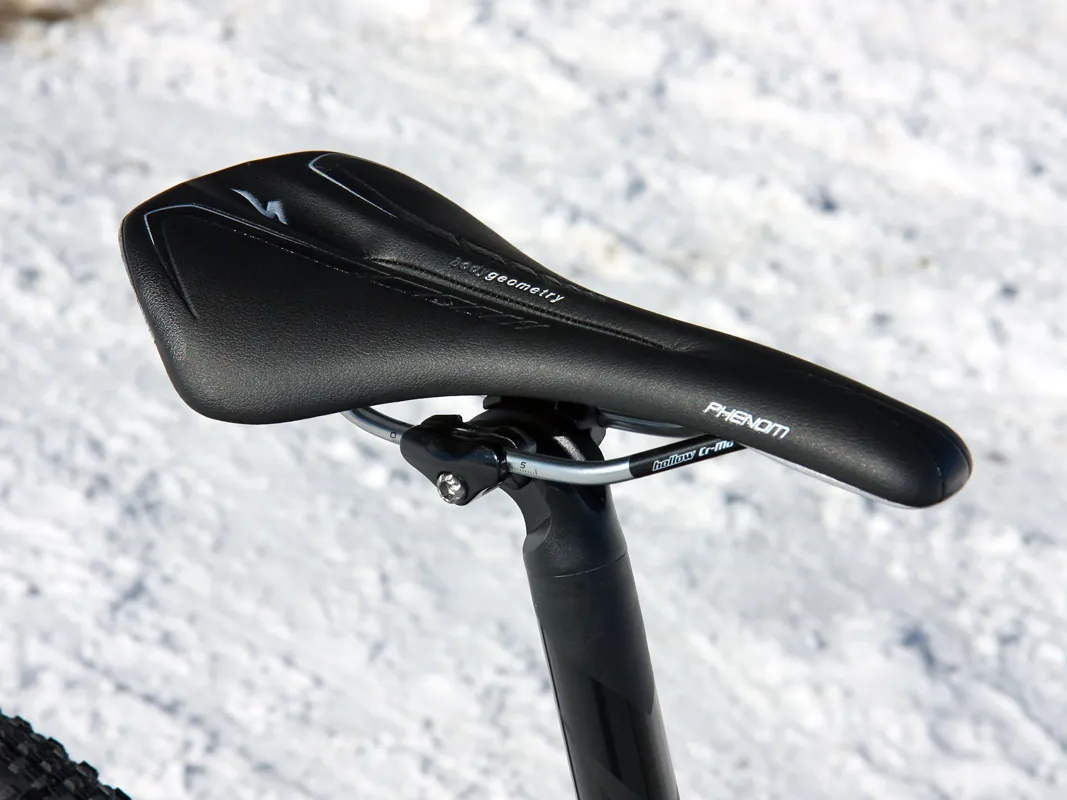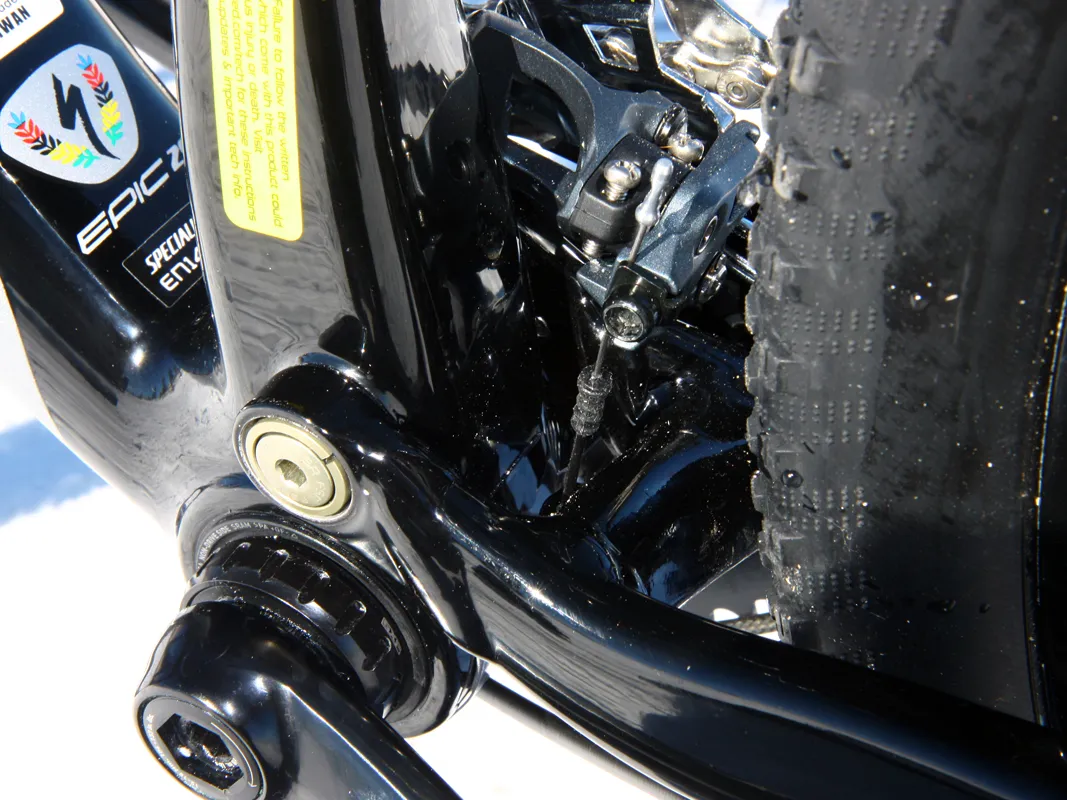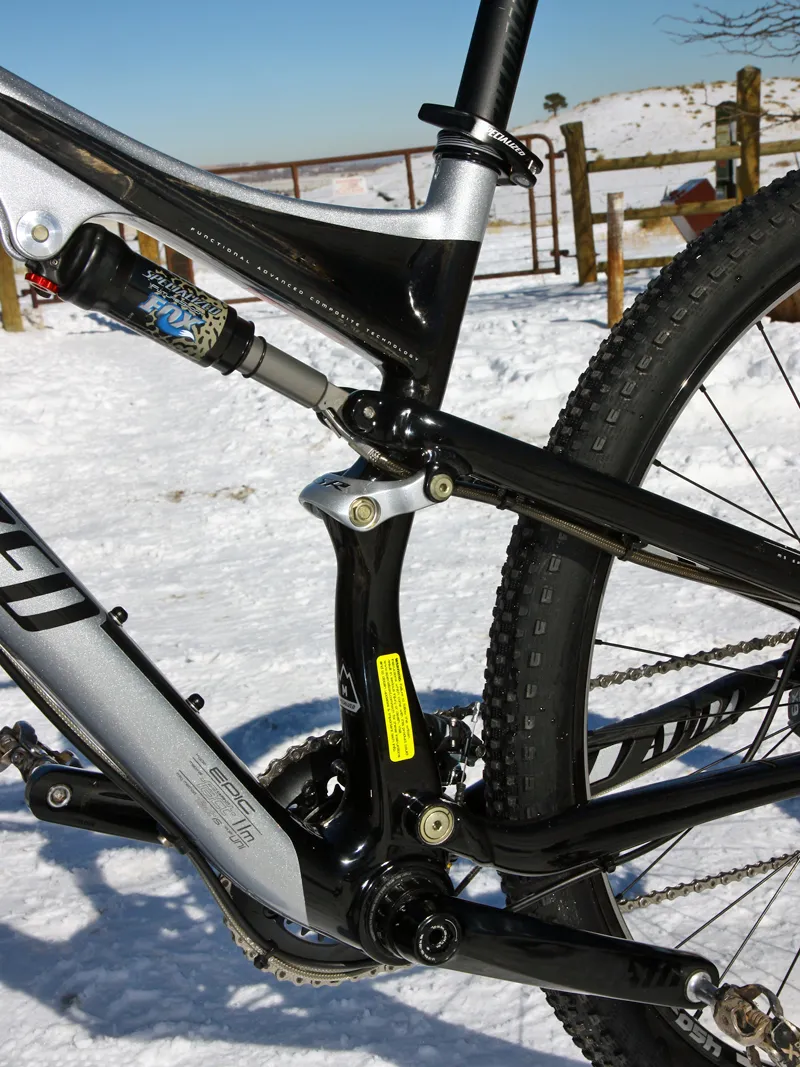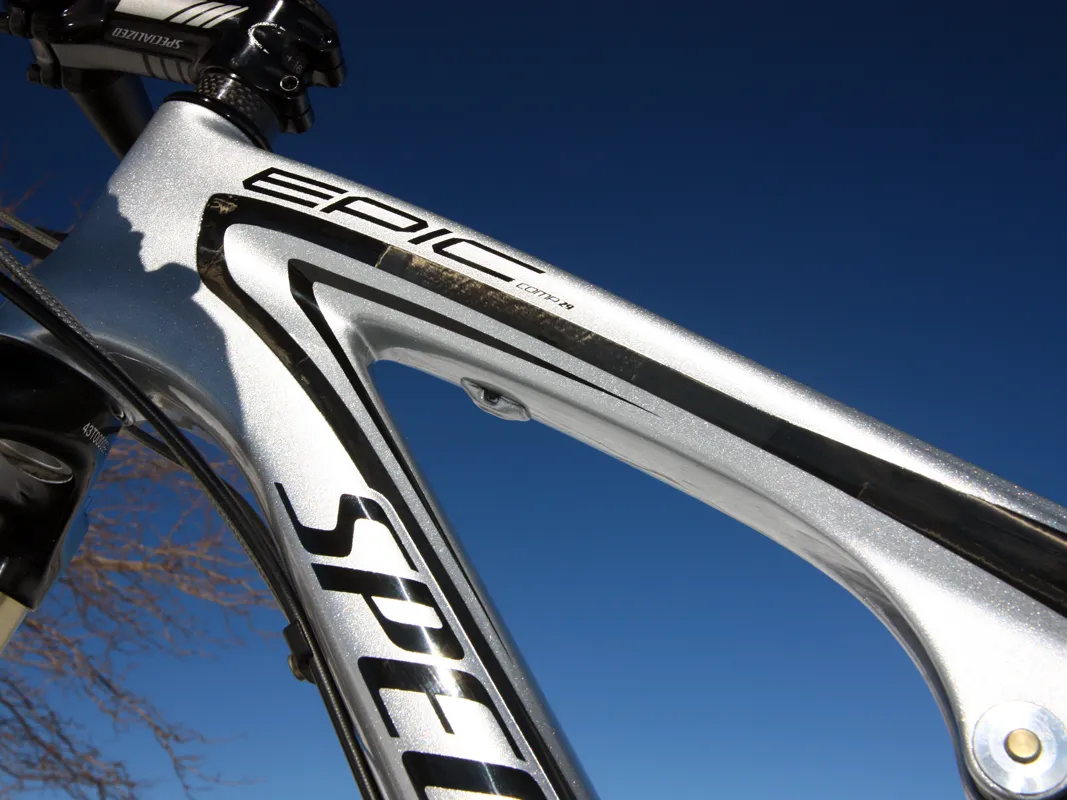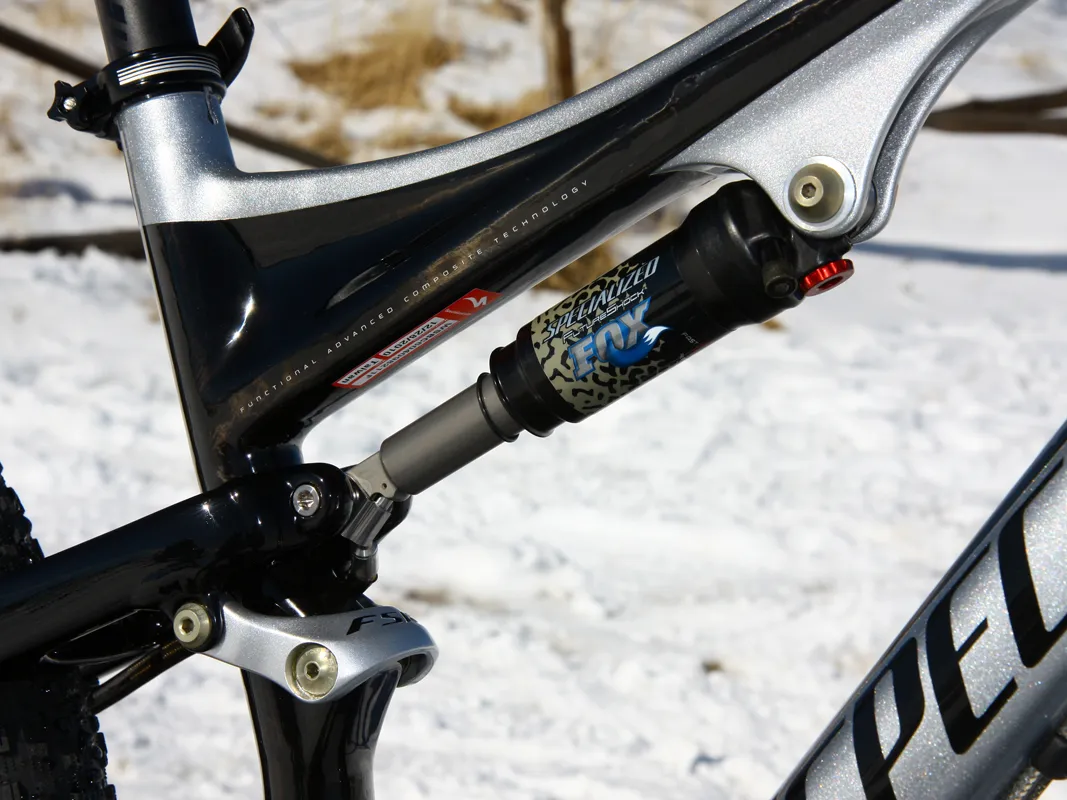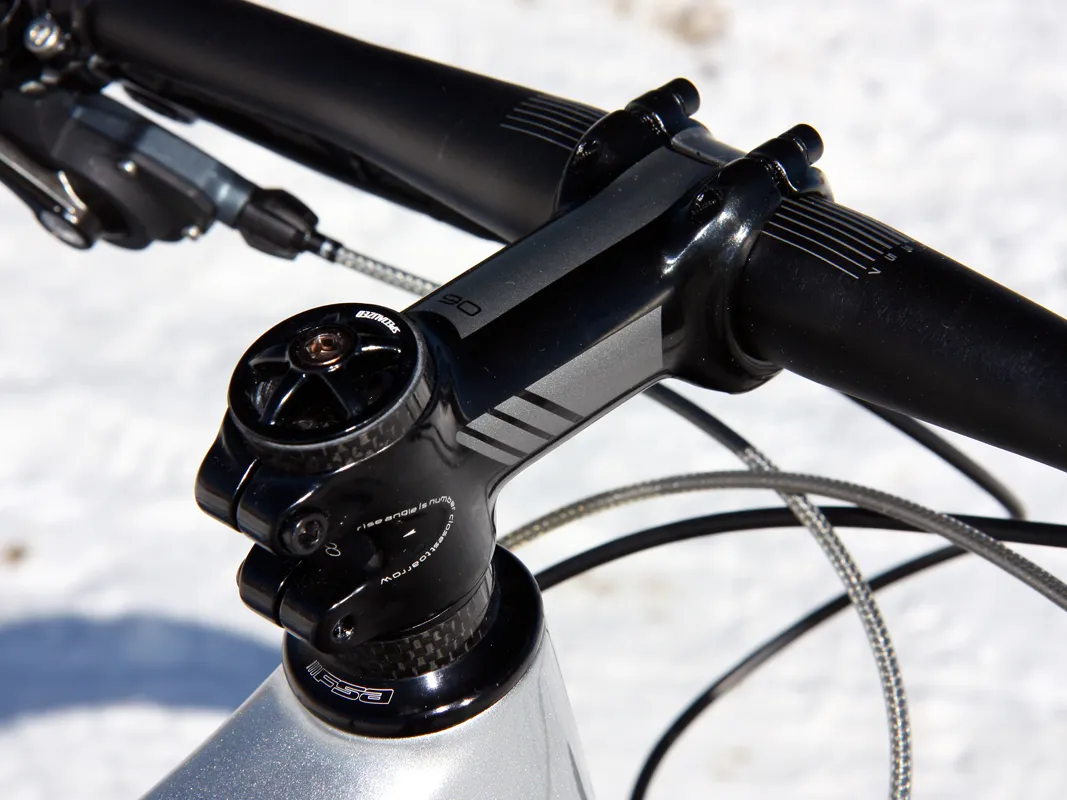Specialized's Epic Comp Carbon 29 is well appointed straight out of the box and offers a stellar suspension package with sorted handling. Hardcore racers will likely want something a bit lighter but it wouldn't be difficult to cleave some significant mass later on as parts wear out, and the frame is well worth additional upgrades.
Ride & handling: For cross-country use and marathon-type events, this thing is just about dialed
The Epic Comp Carbon 29 is an excellent companion for those fast, all-day cross-country trail outings when you've got a lot of ground to cover and little time to do it. The proven four-bar rear suspension design lends 100mm of smooth travel while the corresponding Brain auto-lockout shock ensures it only moves when it should. The carbon fiber front triangle saves some weight and adds handling precision over an equivalent aluminum structure, and fast-rolling 29in wheels devour smaller obstacles and help maintain momentum.
As has been the case for years, one of the brightest points of Specialized's 'FSR' shorter-travel full-suspension designs is the true four-bar rear end's ultra-active personality that stands in contrast to some other short-travel configurations that can have a distinctly tauter feel, particularly over smaller trail features. On rougher terrain the Epic setup is fantastically adept at maintaining tire contact and has a gently progressive spring rate that makes good use of its modest 100mm of travel while still lending that characteristically smooth, pillowy ride that oftentimes can literally save your ass after a long day.
Unlike even the best standalone four-bar variants, though, the auto-lockout FlowControl Mini Brain rear shock only lets the suspension do its thing when needed so that supple performance is also paired with superb pedaling efficiency – and now that Fox Racing Shox handle the shock manufacturing, these latest units actually seem to be holding up as they should.
It sounds too good to be true but the Brain genuinely does work: dial in the bump threshold to your desired level of firmness and there's zero visible movement on smoother ground whether you're deftly spinning away in the saddle or mashing gears out of it. Epic-equipped Specialized factory team riders have even racked up some notable victories in short track – a discipline rife with violent efforts and pedaling bursts that will decimate spongier setups.
Moreover, the switch from locked-out to active is instant and very predictable, particularly in more technical areas where you really need to know if the suspension is going to move beneath you. In most cases the transition from open to closed is nearly imperceptible, though it can take a few rides to get used to the feel at firmer threshold settings. At that end of the range, the system still opens up at the first obstacle you encounter but the sensation – and sound, oddly enough – is eerily similar to bottoming out a tire on a rock.
Handling characteristics are well suited to the Epic Comp Carbon 29's all-day persona, with a not-too-quick 70.5-degree head tube angle (remember, we're talking about 29in wheels here) and the same bottom bracket height as Specialized's 26in Epic. Coupled with the 680mm flat bar you can confidently toss the Epic into dicey high-speed corners, lean on that outside pedal and firmly set your line with little chance of getting bounced off. The wheelbase is just 13mm longer than the smaller-wheeled Epic, too, so the bike is still appropriately eager to switch direction.
While the wheelbase is only slightly longer than the 26in equivalent, the more substantial total end-to-end length can still make for tough going in especially tight situations where you need every bit of space to maneuver. It's a bit of a two-edged sword: the bigger wheels more easily claw their way up and over obstacles, especially at slower speeds, but you've got to be a little more aware of where everything is. This played out on one particularly tight uphill switchback on one of our regular test loops that's tricky on even longer-travel 26in bikes on account of its rocky ledge right at the apex but we consistently nailed it on the Epic Comp Carbon 29.
Specialized don't equip the Epic Comp Carbon 29 with a through-axle fork but front-end rigidity is still better than one might expect even when there are a lot of lateral loads on the front wheel. The bulbous carbon main triangle includes a tapered head tube and matching aluminum steerer while the conventional quick-release open dropouts couple with an old-yet-new trick: giant hub end caps (think back to aftermarket offerings in the early '90s) that offer better bracing against unwanted movement than conventional dimensions plus a through-bolt skewer (the return of the Skraxle!) with a repositionable lever design borrowed from DT Swiss.
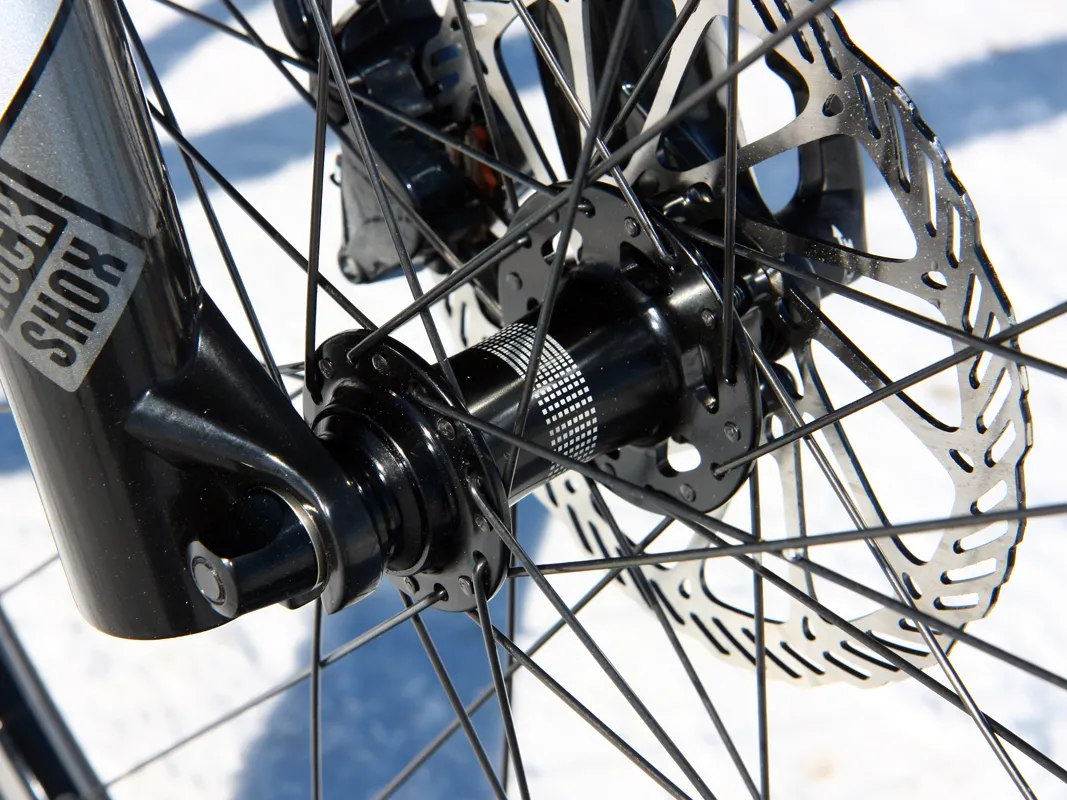
Frame: Carbon-plus-aluminum keeps weight down without breaking the bank
The Carbon Comp 29 is Specialized's least expensive model in the Epic family to come equipped with a composite frame. Lesser fiber blends are used relative to the top-end versions to help keep costs down and there's also a welded aluminum rear triangle instead of a full-carbon setup, but still with cartridge bearing pivots throughout. As a result, the 2.63kg (5.80lb) frame weight is good but not great considering the short travel and US$4,300 pricetag. That the bike rides and pedals so well is further testament to the Brain's effectiveness and the refined suspension design.
As well as the aforementioned tapered front end, Specialized also equip the Epic Comp Carbon 29 frame with a PressFit 30 bottom bracket shell – though in this case, it's filled with an adapter for threaded cups. There are also extra guides to run a remote telescoping seatpost if so desired. Features like these mean the frame shouldn't be outdated too quickly.
Specialized may have downgraded to aluminum stays but the designers have thankfully retained the clever 142 Plus rear hub system. Similar to the X-142 system originally developed by Syntace, 142 uses through-axle rear dropouts and a wider 142mm outside-to-outside hub dimension for a stiffer rear end. Specialized go one step further, however, by also pushing the business ends of the hub a few millimeters further apart for better spoke bracing angles and improved wheel stiffness (other 142mm hubs generally use the same shells as conventional 135mm OLD models).
Guided dropouts make for speedier rear wheel changes relative to many other through-axle designs, too, while the clever replaceable rear derailleur hanger design means you only have to carry spare aluminum bolts (one extra is included), not complete hangers. The post mount rear brake tabs are compatible with 140mm rear rotors should you decide to go all weight weenie with upgrades later on.
Wider rear hub spacing notwithstanding, there's still one Achilles' heel in terms of rear-end flex: the diminutive seat tube-mounted swing link. True, it's light and tidy but also only minimally braced where the seatstays attach, resulting in a hint of lateral flex when you're really leaning hard through a corner.

Equipment: Awesome spec – give that product manager a raise
One might be forgiven for describing the parts package on the Epic Comp Carbon 29 as 'eclectic' but in reality, the somewhat hodgepodge selection of bits has been carefully tweaked to extract the most benefit from the 29in wheels while also helping the bike feel faster than its 12.02kg (26.5lb, without pedals) weight might otherwise suggest.
Wheels are fairly conventional, with tubeless-compatible alloy rims made by DT Swiss and sealed cartridge bearing hubs front and rear. They're light enough and adequately rigid, plus they held up well during testing with the exception of one small dent (that was easily repaired later) after an especially nasty rock hit. Specialized have wrapped the wheels with their top-end S-Works Renegade and Captain tires.
The low-knob Renegade rolls ridiculously quickly, grabs surprisingly well on bare rock and floats through deep sand, yet still offers decent drive traction even on looser terrain if you get your pressures right (just stay away from mud). At the other end, the knobbier Captain delivers a more confident purchase to pull you through a wider range of conditions. Cornering grip up front is good on loose or soft dirt but sketchy on loose-over-hardpack or hardpack – and overall performance on exposed rock could definitely be better.
Both tires are truly feathery at well under 500g apiece to help mask the 29in wheels' greater mass. Bear in mind that they come equipped with tubes from the factory but are readily convertible to tubeless – lopping 130g of rotating weight off in the process. Just be mindful on jagged rocks as the paper-thin casings sacrifice some durability to shed those grams.
SRAM handle the lion's share of the spec with their RockShox Reba RLT 29 fork, Avid Elixir R SL brakes (custom tuned for Specialized with alloy-backed pads), an X9 rear derailleur and an X7 direct-mount front derailleur and trigger shifters. The lone exceptions are a KMC chain and smooth-shifting Shimano 12-36T cassette.
Braking power and modulation was ample and predictable – though we definitely missed the bite point adjustment to balance the two sides – and there was little to fault with the shifting performance aside from the disappointing lack of tactile feedback in the X7 triggers. The SRAM S-1250 crankset isn't especially light with its solid-forged arms but on the plus side, Specialized have fitted 24/38T chainrings that are better suited to the Epic's 29in wheels than SRAM's stock two-ring offerings. The latest GXP external-bearing bottom bracket also spins with far less friction than earlier units without the latest Gutter seal design.
The rest of the bike is finished off with Specialized-branded bits including the aforementioned flat alloy bar, the handy adjustable-angle aluminum stem, the competent alloy seatpost with its easily adjusted and secure one-bolt head, and well shaped (if perhaps a tad firm) Phenom Comp saddle.
More detailed thought can be found in the disc rotors and lock-on grips, both of which vary in diameter with frame size. Heck, even the down tube comes with thick protective tape pre-applied to the underside to guard against rock strikes. Some might lament the brake and derailleur lines dangling below the bottom bracket shell but we had no problems during testing.
